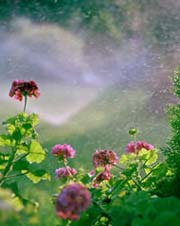Lessons in landscape

Some plants don’t like their water second-hand. <br>© Photodisc <br>
Keeping parks pretty means tailoring the trees to their source of water.
Irrigation water recycled from sewage can damage many plant species, new research has found1. The results show that landscape architects should tailor their choice of plants to the type of water they will receive.
Dale Devitt of the University of Nevada at Reno and colleagues began studying the effects of different water sources on plants after reports that ’reuse’ water had damaged trees and shrubs on Las Vegas golf courses. Reuse water is sewage water that has had the most serious pollutants removed but has not been restored to drinkable quality.
The researchers compared the effects of sprinkling plants with either reuse water or drinking-quality municipal water.
Most of the 20 plant species treated with reuse water showed signs of leaf damage relative to those irrigated with drinking water. Elms and desert willows were among the worst affected. Some species, such as Modesto ash and mimosa, were damaged even by drinking water.
All three of the pine species they studied were robust, however. This is fortunate, as pines are common to many parks, golf courses and other ornamental landscapes in Nevada.
Waste not
Reusing ’waste water’ is one of the most promising means of irrigating arid regions. Tucson and Phoenix in Arizona both run water reclamation schemes, for example. In Israel, 70% of the country’s sewage is treated and used for agricultural irrigation – pollutants become valuable fertilizers.
“The major barriers to reusing waste water are psychological, not technical,” says Sandra Postel of the Global Water Policy Project in Massachusetts.
But the Reno team’s results suggest that at least one technical barrier remains. Reuse water retains substances that may damage delicate plants. In particular, it is relatively high in salts.
References
- Jordan, L. A., Devitt, D. A., Morris, R. L. & Neumann, D. S. Foliar damage to ornamental trees sprinkler-irrigated with reuse water. Irrigation Science, advanced online publication DOI: 10.1007/s00271-001-0050-y (2001).
Media Contact
More Information:
http://www.nature.com/nsu/011206/011206-9.htmlAll latest news from the category: Ecology, The Environment and Conservation
This complex theme deals primarily with interactions between organisms and the environmental factors that impact them, but to a greater extent between individual inanimate environmental factors.
innovations-report offers informative reports and articles on topics such as climate protection, landscape conservation, ecological systems, wildlife and nature parks and ecosystem efficiency and balance.
Newest articles

Silicon Carbide Innovation Alliance to drive industrial-scale semiconductor work
Known for its ability to withstand extreme environments and high voltages, silicon carbide (SiC) is a semiconducting material made up of silicon and carbon atoms arranged into crystals that is…

New SPECT/CT technique shows impressive biomarker identification
…offers increased access for prostate cancer patients. A novel SPECT/CT acquisition method can accurately detect radiopharmaceutical biodistribution in a convenient manner for prostate cancer patients, opening the door for more…

How 3D printers can give robots a soft touch
Soft skin coverings and touch sensors have emerged as a promising feature for robots that are both safer and more intuitive for human interaction, but they are expensive and difficult…





















